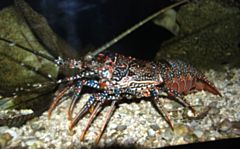Project 2077: H. D. Bracken-Grissom, S. T. Ahyong, R. D. Wilkinson, R. M. Feldmann, C. E. Schweitzer, J. W. Breinholt, M. Bendall, F. Palero, T. Chan, D. L. Felder, R. Robles, K. Chu, L. Tsang, D. Kim, J. W. Martin, K. A. Crandall. 2014. The Emergence of Lobsters: Phylogenetic Relationships, Morphological Evolution and Divergence Time Comparisons of an Ancient Group (Decapoda: Achelata, Astacidea, Glypheidea, Polychelida). Systematic Biology. 63 (4):457-479.
Abstract
Lobsters are a ubiquitous and economically important group of decapod crustaceans that include the infraorders Polychelida, Glypheidea, Astacidea and Achelata. They include familiar forms such as the spiny, slipper, clawed lobsters and crayfish and unfamiliar forms such as the deep-sea and “living fossil” species. The high degree of morphological diversity among these infraorders has led to a dynamic classification and conflicting hypotheses of evolutionary relationships. In this study, we estimated phylogenetic relationships among the major groups of all lobster families and 94% of the genera using six genes (mitochondrial and nuclear) and 195 morphological characters across 173 species of lobsters for the most comprehensive sampling to date. Lobsters were recovered as a non-monophyletic assemblage in the combined (molecular + morphology) analysis. All families were monophyletic, with the exception of Cambaridae, and 7 of 79 genera were recovered as poly- or paraphyletic. A rich fossil history coupled with dense taxon coverage allowed us to estimate and compare divergence times and origins of major lineages using two drastically different approaches. Age priors were constructed and/or included based on fossil age information or fossil discovery, age, and extant species count data. Results from the two approaches were largely congruent across deep to shallow taxonomic divergences across major lineages. The origin of the first lobster-like decapod (Polychelida) was estimated in the Devonian (∼409–372 Ma) with all infraorders present in the Carboniferous (∼353–318 Ma). Fossil calibration subsampling studies examined the influence of sampling density (number of fossils) and placement (deep, middle, and shallow) on divergence time estimates. Results from our study suggest including at least 1 fossil per 10 operational taxonomic units (OTUs) in divergence dating analyses. [Dating; decapods; divergence; lobsters; molecular; morphology; phylogenetics.]Read the article »
Article DOI: 10.1093/sysbio/syu008
Project DOI: 10.7934/P2077, http://dx.doi.org/10.7934/P2077
| This project contains |
|---|
Download Project SDD File |
Currently Viewing:
MorphoBank Project 2077
MorphoBank Project 2077
- Creation Date:
01 December 2014 - Publication Date:
31 March 2022
This research
supported by
Authors' Institutions ![]()
- Brigham Young University
- Florida International University
- Chinese University of Hong Kong
- The George Washington University
- University of Nottingham
- Australian Museum
- University of New South Wales
- Universidade de Sao Paulo (USP, University of Sao Paulo)
- Universitat de València
- National Taiwan Ocean University
- Kent State University
- Natural History Museum of Los Angeles County
- University of Louisiana
- Florida Museum of Natural History
Members
| member name | taxa |
specimens |
media |
| MorphoBank Curator Project Administrator | 0 | 0 | 0 |
| Maureen Admin Full membership | 3 | 2 | 2 |
| Heather Bracken-Grissom Full membership | 0 | 0 | 0 |
Project has no matrices defined.
Project downloads 
| type | number of downloads | Individual items downloaded (where applicable) |
| Total downloads from project | 7 | |
| Project downloads | 7 |

